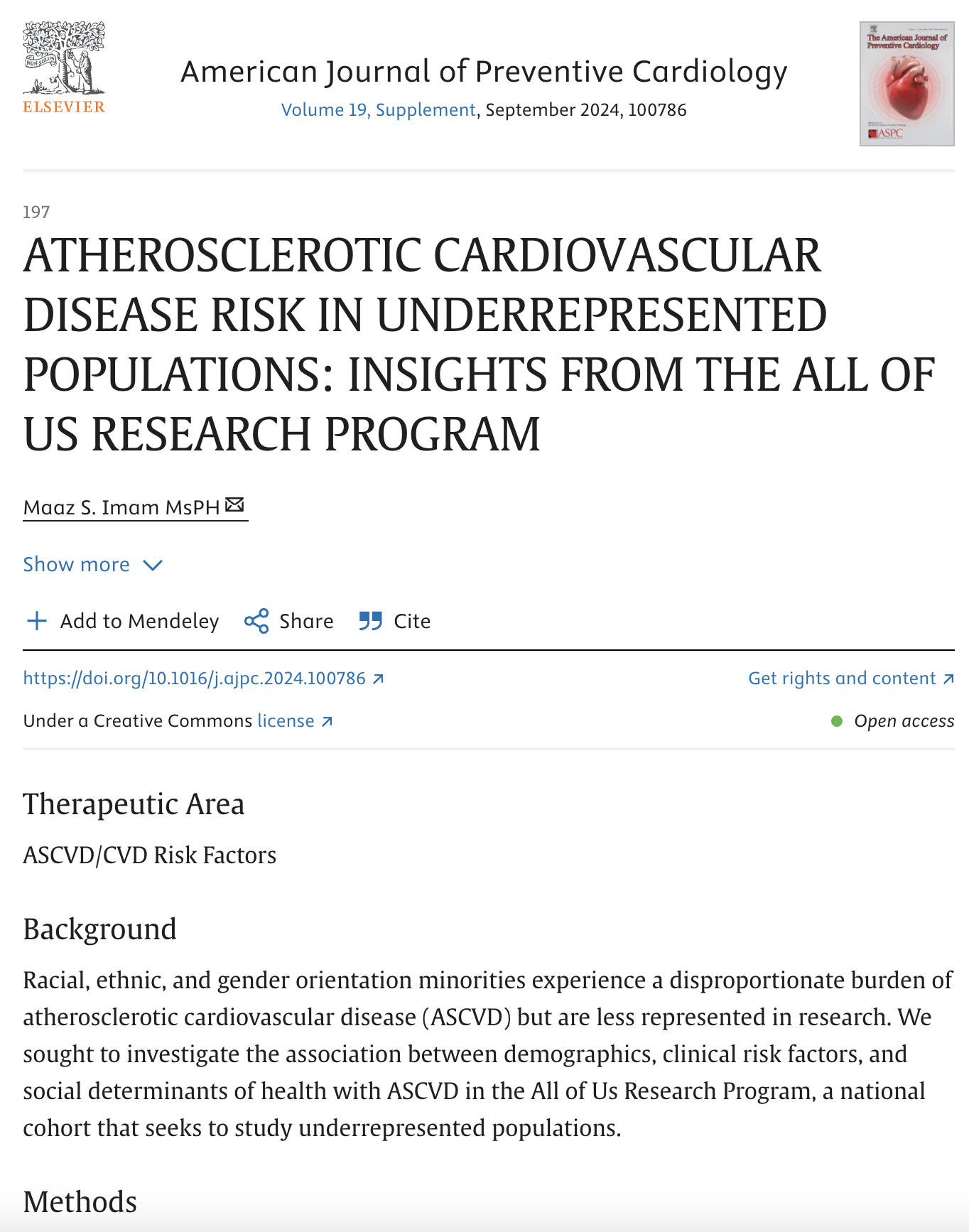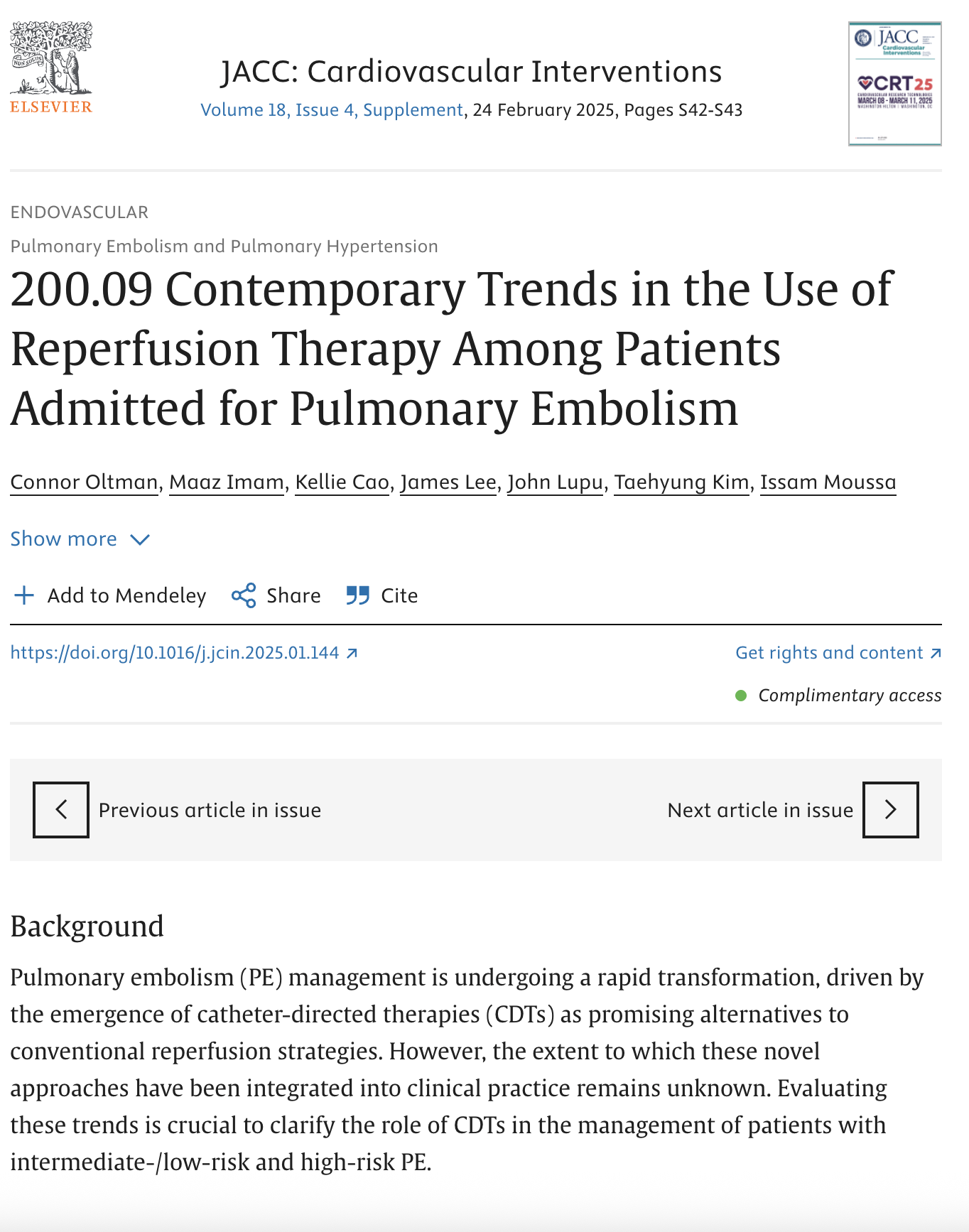What if we could spot a heart attack years before it happens — in the patients most likely to be overlooked?
I’m exploring how social risk, structural disparities, and underused data sources shape cardiovascular outcomes in historically excluded populations. The goal is to build smarter systems that see the warning signs earlier and act sooner.
Science
-

ATHEROSCLEROTIC CARDIOVASCULAR DISEASE RISK IN UNDERREPRESENTED POPULATIONS: INSIGHTS FROM THE ALL OF US RESEARCH PROGRAM
Question
What demographic, clinical, and social determinants of health are associated with ASCVD prevalence in a large, diverse U.S. cohort?Findings
Among 251,116 adults in the All of Us Research Program (2017–2024), 12.3% had documented ASCVD. In multivariate logistic regression, ASCVD was significantly associated with older age, male gender, transgender and non-binary gender identities, Black and Native Hawaiian/Pacific Islander race, lower annual income (<$50,000), higher area deprivation index scores, and traditional clinical risk factors including type 2 diabetes, hypertension, and hyperlipidemia. Obesity was not independently associated with ASCVD after adjustment.Meaning
In this nationally representative cohort, multiple social and demographic factors — alongside established clinical risks — were significantly associated with ASCVD. These findings highlight the importance of considering both medical and social determinants when evaluating cardiovascular disease prevalence in diverse populations. -

Contemporary Trends in the Use of Reperfusion Therapy Among Patients Admitted for Pulmonary Embolism
Question
How have reperfusion strategies for pulmonary embolism (PE), particularly catheter-directed therapies, changed in clinical practice from 2016 to 2023?Findings
In a national cohort of 205,979 hospitalized PE patients, use of reperfusion therapies increased significantly between 2016 and 2023. Among high-risk PE admissions (n = 11,003), reperfusion rates rose modestly from 29.9% to 33.0% (p < 0.001). Among intermediate-/low-risk cases (n = 194,976), usage more than doubled from 5.3% to 11.2% (p < 0.001). In both groups, catheter-directed embolectomy emerged as the dominant reperfusion method by 2021.Meaning
Catheter-directed embolectomy has rapidly become the leading reperfusion strategy for both high-risk and intermediate-/low-risk PE patients. This shift underscores a critical need for further evaluation of its safety and effectiveness across varying levels of disease severity. -

Clinical Characteristics, Outcomes, and Management of Patients Admitted for Saddle, Non-saddle, and Subsegmental Pulmonary Embolism
Question
How do clinical characteristics, complications, and treatment patterns differ across subtypes of pulmonary embolism (saddle, non-saddle, and subsegmental) in hospitalized patients?Findings
In a cohort of 150,919 patients hospitalized with PE from 2020 to 2023, 5.84% had saddle PE, 87.85% non-saddle PE, and 6.31% subsegmental PE. Saddle PE cases had higher rates of severe complications, including cardiogenic shock (5.75%) and cardiac arrest (2.73%), compared to non-saddle and subsegmental cases (all p < 0.01). Saddle PE was also more frequently treated with catheter-directed embolectomy (28.84%). Anticoagulation was used at similar rates across all subtypes, despite ongoing debate regarding surveillance in subsegmental PE.saddle PE, 87.85% non-saddle PE, and 6.31% subsegmeMeaning
Saddle, non-saddle, and subsegmental PEs exhibit distinct clinical profiles and management approaches. These findings highlight the need for subtype-specific protocols to improve risk stratification and treatment decision-making across the full spectrum of PE presentations.
Tools in Development
This research asks:
Can we refine cardiovascular care by learning from the patients and patterns that traditional models often overlook?
To explore that, I am working with a team to develop of a discharge assistant designed to embed clinical intelligence into one of the most critical — and overlooked — moments in cardiology workflows.
-
A HIPAA-safe, AI-powered assistant that generates structured, risk-aware discharge summaries for cardiology patients. This tool is designed to streamline documentation for cardiology fellows and improve the quality and consistency of discharge communication.